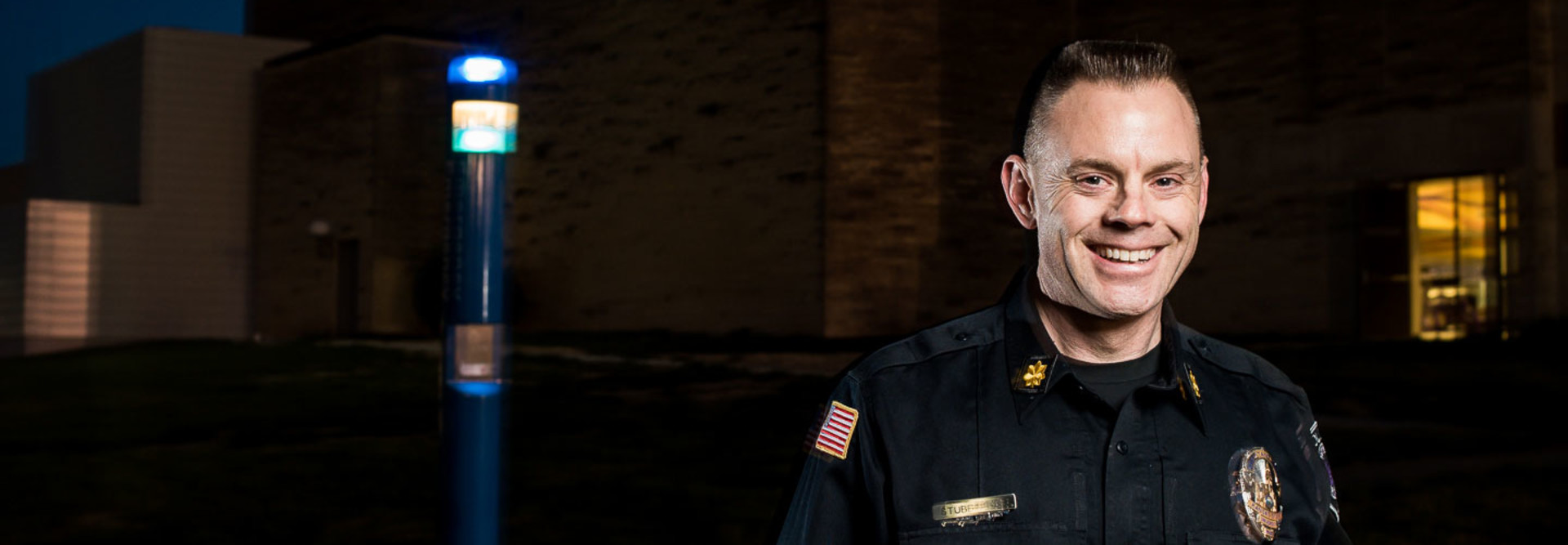Tech Solutions Bolster Campus Security and Improve Emergency Response
For years, the “blue light” on college campuses has been synonymous with safety.
When students are afraid for any reason, they know they can get to one of the phones topped with a blue light, pick up the receiver and help will be on the way.
But now, many (if not most) students carry a virtual blue light in their pockets, in the form of a cellphone. Not only can they use their phones to call campus police if they witness suspicious activity or feel they’re in danger, but also students at a growing number of colleges have access to mobile apps designed to promote campus safety.
Last year, Kansas State University rolled out the LiveSafe app, which lets students quickly report crimes from a drop-down menu, provides one-touch access to 911 and even lets friends track one another to make sure everyone gets home safe at the end of the night.
“It’s an incredible app,” says Maj. Donald Stubbings, assistant director for support services at the Kansas State University Police Department. “It’s almost a one-stop shop for safety. We’ve had reports of everything from loud parties to suspicious activities and loose dogs.” The app also lets users take and transmit photographs, which helps officers assess a situation before they arrive or gives them a visual reference for suspects and vehicles.
The Adoption of Tech Tools Accelerates
Kansas State still has its blue-light phones (just as the campus still has locks on its doors and sends its police officers out to patrol the campus). But increasingly, colleges and universities are using tech solutions to bolster physical security, handle emergencies and empower students and faculty to report crimes.
“Almost any technology that is being used by a municipal police system is probably being considered by campus police departments as well,” says William F. Taylor, president of the International Association of Campus Law Enforcement Administrators and the chief of police at Collin College in Plano, Texas.
“Our college is going through a dramatic change in things like overall building security,” Taylor says. “The next step is integration — using cameras in conjunction with access control and moving toward systems that are smart and analytical. We’re in the process of developing all of that here, and a lot of campuses have already done it.”
As an example, Renee Patton, U.S. public-sector director for Cisco Systems, points to the pairing of facial recognition software and access control systems. In residence halls, an integrated system could take pictures of everyone who enters for comparison against student information, alerting security personnel or front desk staff to unfamiliar faces.
Campuses Move from Analog to Analytics
The University of Tulsa has already integrated about 640 IP-enabled cameras with 200 legacy analog cameras, says Will Redding, assistant director of security technology and card services.
The university opted for cameras from Axis Communications, because of their sharp picture and because they work seamlessly with the university’s Ocularis On-Net Surveillance Systems video management system. The university uses AXIS P33 Series and AXIS Q1765 Fixed Network Cameras, among other models.
“There’s virtually zero integration,” Redding says. “It just works. And the quality is superb.”
In fact, Redding says, the university uses Axis encoders to tie in its old analog cameras with the video management system. Together, the cameras and the video management system allow security personnel to investigate quickly. If something happens to a portrait in the art museum, for example, investigators can search relevant footage rather than rewinding and fast-forwarding through hours of recordings.
Public Safety Is Always on Alert
In addition, the AXIS Cross Line Detection feature lets security personnel set a virtual “tripwire” that alerts public safety workers when that line is crossed. This is particularly useful in monitoring parking lots overnight, when the university wants to monitor every vehicle that comes and goes.
Redding is testing a setup that will enable cameras to report anomalous activity to one another. For example, a fixed camera might spot a car entering a parking lot at night via the Cross Line feature and then send a signal to a pan/tilt/zoom camera to follow the vehicle’s path.
“We have 600-plus IP cameras,” Redding notes. “A human can’t watch all those cameras at once. We need to create the analytics so that the cameras can report back to us and only report on what’s going wrong, outside the norm.”
Institutions Ready for the Worst
Although the vast majority of students will never experience an active-shooter situation, the grim reality is that some will. Campus public safety departments deploy a number of tech tools with that scenario in mind.
“Virtually every campus has some sort of technology-enabled emergency notification system,” notes Kevin Kruger, president of NASPA, an association of student affairs administrators.
Many campuses, Kruger says, are upgrading analog systems to Wi-Fi-enabled systems. These newer products let campus safety agencies commandeer digital displays and projection screens in classrooms, replacing professors’ lecture notes with critical messages.
NorthWest Arkansas Community College, for example, upgraded to an IP-based emergency notification system, IPcelerate IPsession. “We can send to locations all over campus,” says Ethan Beckcom, executive director for institutional policy, risk management and compliance at NWACC. “We can send messages to boards that scroll the information, to speakers where everyone can hear it, and to any conference phone on campus.”
In some cases, tech solutions can prevent shooters from moving freely about campus, Kruger says. “In the old days, when everybody had a physical key, there was an awful lot of risk related to propping doors,” he says. “Now it’s much more common for locks to all be key-carded. In more advanced systems, you have the capacity to lock the building down. You can potentially create a barrier for an active shooter going from building to building.”
Kansas State’s notification system lets officials choose from several channels, including phone calls, text messages, social media, website posts and digital displays across campus. Recently, officials used the system to notify people of an armed robbery suspect on campus. Combined with social media exposure, 350,000 people got the message, Stubbings says.
“It gave people the description of the suspect,” he notes. “It gave them the option of locking down or not coming onto campus. It’s hard to measure the impact when something bad doesn’t happen. But there were no injuries. The suspect was later arrested. We got a lot of positive feedback about how that message went out.” Social media and mobile apps also help campus safety departments broadcast important messages. NWACC uses an app called In Case of Crisis, which about 20 percent of faculty, staff and students have adopted. In addition to giving quick access to the campus safety department’s phone number, the app includes building maps, evacuation routes and other safety information.
Social media channels are incredibly important, Stubbings says. In one instance, Kansas State police captured a still photo from a security camera of a suspect who was stealing personal items at the on-campus veterinary hospital. Police pushed the photo out via social media and identified the suspect in 53 minutes.

Cameras Keep a Watchful Eye
Still photos from video systems can only help identify suspects when they are high-quality images, of course. NWACC began switching to IP-enabled cameras more than a decade ago and is currently investing in equipment from Milestone Systems. IP-enabled cameras are favored, says Jason Degn, associate vice president for IT, for both cost advantages and the ability to run power and data over a single cable with Power over Ethernet.
The school gravitated toward Milestone Systems in part because of the ease of use of its software, Beckcom says. “The biggest thing for us has been the ability for any of our officers to have the knowledge to come in and pull video, as it relates to any type of investigation,” he says. “It’s so user-friendly that really anybody can pick that up and run with it.”
Collin College’s police officers use both in-car and body-worn cameras. Taylor says the college is upgrading its systems so that body cameras will instantaneously transmit data to a storage device in police cruisers, which will automatically sync with department servers when cars return to the station.
Although Collin campus police often use a community policing model — and sometimes refer cases to a school’s disciplinary arm rather than to the court system — Taylor says high-tech tools help officers prepare for anything.
“We can’t control criminals and what they decide to do,” Taylor says. “Almost no campus in this country has walls or fences around it. Anything that can happen in a local community can happen on a college campus, and then the officers there are faced with it.”









